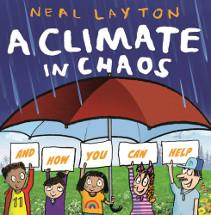A climate in chaos by Neal Layton

Hachette, 2020. ISBN: 9781526362315.
(Age: 6+) Highly recommended. In young reader friendly language,
Neal Layton explains how the world got to be in the mess it is in.
We rely on breathing out carbon dioxide after taking in oxygen, and
plants take in carbon dioxide, breathing out oxygen. The greenhouse
gas layer kept us warm. So it has been for millions of years, but
two hundred years ago we started burning fossil fuel to create
energy to power machines and the balance became uneven. More carbon
dioxide is created, making the greenhouse gas layer too thick and
changing the climate around the world. Added to this the animals
that breathe out carbon dioxide have been farmed, increasing their
number, so creating more carbon dioxide, and human population has
increased rapidly, adding to the amount as well. Trees and forests
which soak up the extra carbon dioxide are being pulled down and the
warmer temperatures are changing our climate.
Animal habitats are being changed as well, making it difficult for
them to survive.
So what can we do about it?
Layton lists his suggestions with regard to transport, consumerism,
waste, food, energy and forests. Each suggestion has a paragraph of
information about how these should be changed for the better. Food,
for example, tells us that eating more plants reduces the impact of
livestock farming, eating food that is grown locally reduces the
need for it to be transported while growing our own is even more
beneficial.
The biggest issue of them all is burning of fossil fuels, and
Layton advocates a change to renewable energy sources, wind, tidal,
geothermal and solar power.
Layton explains what a sustainable house looks like with a drawing
and information around it to show where savings can be made. Many
children will have heard of several suggestions here and some will
be practising some at home, while your school may have solar panels
and a garden, but all put together this makes a fascinating reference for
a classroom to read about and research to find out more information.
Questions will spring up: where do we get recycled loo paper, what
is a composting toilet, does it smell, how can we have a garden on
the roof? And so on. The double page with the sustainable house will
create a great deal of imaginative discussion, and kids will want to
know what their school and council is doing to create a sustainable
pathway for the area. At the end of the book Layton acknowledges the
work being done around the world, and finishes with a list of things
we can all do in the home to create a better environment.
A book well worth reading and sharing.
Themes: Sustainability, Climate change, Greenhouse gas, Fossil
fuels, Future, Renewable energy.
Fran Knight